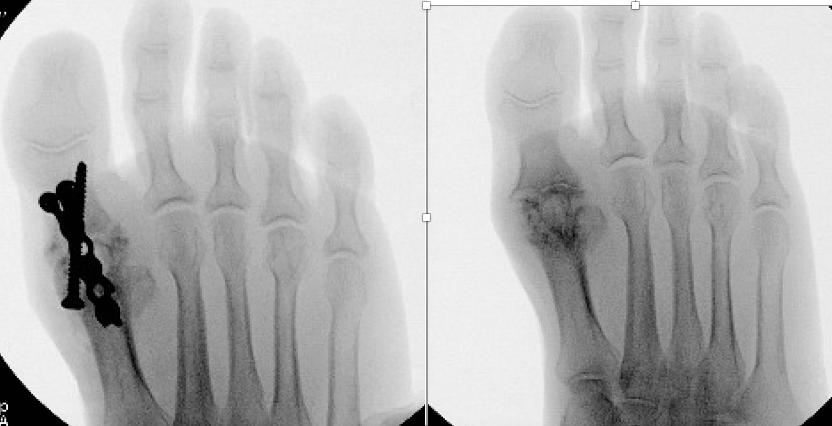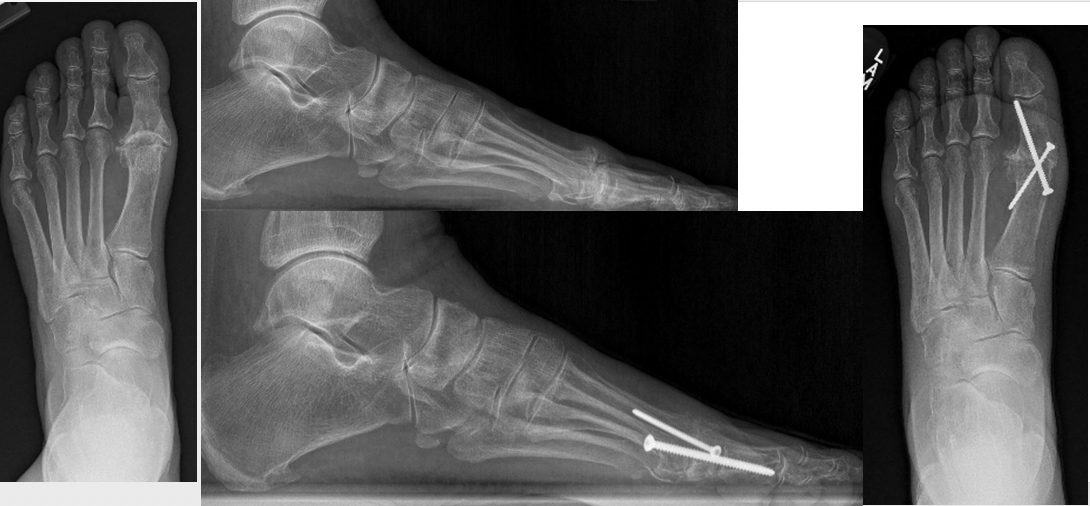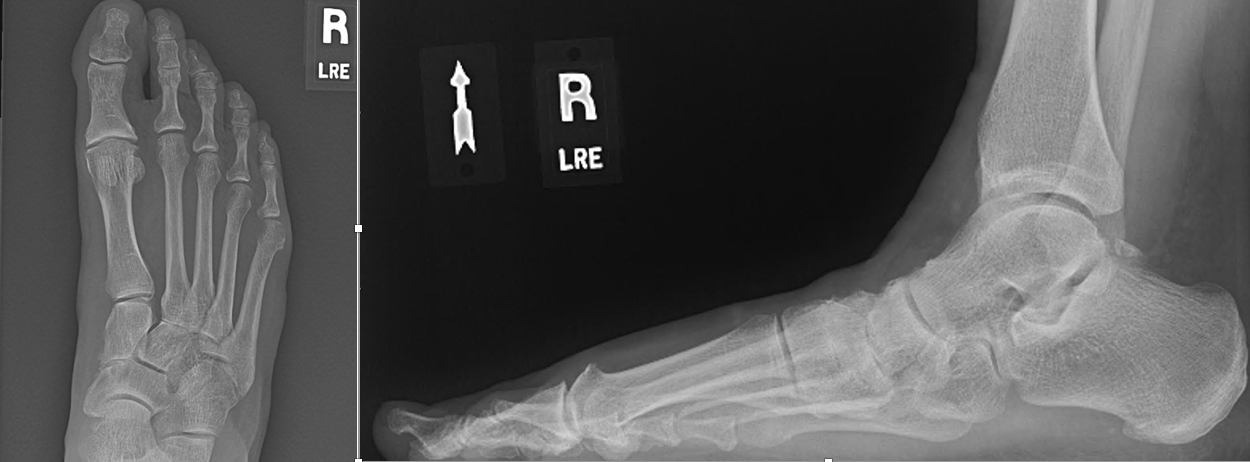[1]
Massimi S, Caravelli S, Fuiano M, Pungetti C, Mosca M, Zaffagnini S. Management of high-grade hallux rigidus: a narrative review of the literature. Musculoskeletal surgery. 2020 Dec:104(3):237-243. doi: 10.1007/s12306-020-00646-y. Epub 2020 Feb 6
[PubMed PMID: 32030657]
Level 3 (low-level) evidence
[2]
Roukis TS. Metatarsus primus elevatus in hallux rigidus: fact or fiction? Journal of the American Podiatric Medical Association. 2005 May-Jun:95(3):221-8
[PubMed PMID: 15901807]
[4]
Galois L, Hemmer J, Ray V, Sirveaux F. Surgical options for hallux rigidus: state of the art and review of the literature. European journal of orthopaedic surgery & traumatology : orthopedie traumatologie. 2020 Jan:30(1):57-65. doi: 10.1007/s00590-019-02528-x. Epub 2019 Aug 7
[PubMed PMID: 31392522]
[5]
Lam A, Chan JJ, Surace MF, Vulcano E. Hallux rigidus: How do I approach it? World journal of orthopedics. 2017 May 18:8(5):364-371. doi: 10.5312/wjo.v8.i5.364. Epub 2017 May 18
[PubMed PMID: 28567339]
[6]
Beeson P, Phillips C, Corr S, Ribbans WJ. Cross-sectional study to evaluate radiological parameters in hallux rigidus. Foot (Edinburgh, Scotland). 2009 Mar:19(1):7-21. doi: 10.1016/j.foot.2008.07.002. Epub 2008 Oct 10
[PubMed PMID: 20307444]
Level 2 (mid-level) evidence
[7]
Calvo A, Viladot R, Giné J, Alvarez F. The importance of the length of the first metatarsal and the proximal phalanx of hallux in the etiopathogeny of the hallux rigidus. Foot and ankle surgery : official journal of the European Society of Foot and Ankle Surgeons. 2009:15(2):69-74. doi: 10.1016/j.fas.2008.08.001. Epub 2008 Oct 1
[PubMed PMID: 19410172]
[8]
Lee HY, Lalevee M, Mansur NSB, Vandelune CA, Dibbern KN, Barg A, Femino JE, de Cesar Netto C. Multiplanar instability of the first tarsometatarsal joint in hallux valgus and hallux rigidus patients: a case-control study. International orthopaedics. 2022 Feb:46(2):255-263. doi: 10.1007/s00264-021-05198-9. Epub 2021 Sep 1
[PubMed PMID: 34468786]
Level 2 (mid-level) evidence
[9]
Bejarano-Pineda L, Cody EA, Nunley JA 2nd. Prevalence of Hallux Rigidus in Patients With End-Stage Ankle Arthritis. The Journal of foot and ankle surgery : official publication of the American College of Foot and Ankle Surgeons. 2021 Jan-Feb:60(1):21-24. doi: 10.1053/j.jfas.2020.04.004. Epub 2020 Nov 5
[PubMed PMID: 33160837]
[10]
Air ME, Rietveld AB. Freiberg's disease as a rare cause of limited and painful relevé in dancers. Journal of dance medicine & science : official publication of the International Association for Dance Medicine & Science. 2010:14(1):32-6
[PubMed PMID: 20214853]
[11]
Senga Y, Nishimura A, Ito N, Kitaura Y, Sudo A. Prevalence of and risk factors for hallux rigidus: a cross-sectional study in Japan. BMC musculoskeletal disorders. 2021 Sep 13:22(1):786. doi: 10.1186/s12891-021-04666-y. Epub 2021 Sep 13
[PubMed PMID: 34517874]
Level 2 (mid-level) evidence
[12]
Botek G, Anderson MA. Etiology, pathophysiology, and staging of hallux rigidus. Clinics in podiatric medicine and surgery. 2011 Apr:28(2):229-43, vii. doi: 10.1016/j.cpm.2011.02.004. Epub
[PubMed PMID: 21669337]
[13]
Walter R, Perera A. Open, Arthroscopic, and Percutaneous Cheilectomy for Hallux Rigidus. Foot and ankle clinics. 2015 Sep:20(3):421-31. doi: 10.1016/j.fcl.2015.04.005. Epub
[PubMed PMID: 26320557]
[14]
Hagedorn TJ, Dufour AB, Riskowski JL, Hillstrom HJ, Menz HB, Casey VA, Hannan MT. Foot disorders, foot posture, and foot function: the Framingham foot study. PloS one. 2013:8(9):e74364. doi: 10.1371/journal.pone.0074364. Epub 2013 Sep 5
[PubMed PMID: 24040231]
Level 3 (low-level) evidence
[15]
Coughlin MJ, Shurnas PS. Hallux rigidus. Grading and long-term results of operative treatment. The Journal of bone and joint surgery. American volume. 2003 Nov:85(11):2072-88
[PubMed PMID: 14630834]
[16]
Colò G, Fusini F, Samaila EM, Rava A, Felli L, Alessio-Mazzola M, Magnan B. The efficacy of shoe modifications and foot orthoses in treating patients with hallux rigidus: a comprehensive review of literature. Acta bio-medica : Atenei Parmensis. 2020 Dec 30:91(14-S):e2020016. doi: 10.23750/abm.v91i14-S.10969. Epub 2020 Dec 30
[PubMed PMID: 33559617]
[17]
Braun HJ, Wilcox-Fogel N, Kim HJ, Pouliot MA, Harris AH, Dragoo JL. The effect of local anesthetic and corticosteroid combinations on chondrocyte viability. Knee surgery, sports traumatology, arthroscopy : official journal of the ESSKA. 2012 Sep:20(9):1689-95. doi: 10.1007/s00167-011-1728-1. Epub 2011 Oct 29
[PubMed PMID: 22037813]
[18]
Kunnasegaran R, Thevendran G. Hallux Rigidus: Nonoperative Treatment and Orthotics. Foot and ankle clinics. 2015 Sep:20(3):401-12. doi: 10.1016/j.fcl.2015.04.003. Epub 2015 Jun 9
[PubMed PMID: 26320555]
[19]
Sidon E, Rogero R, Bell T, McDonald E, Shakked RJ, Fuchs D, Daniel JN, Pedowitz DI, Raikin SM. Long-term Follow-up of Cheilectomy for Treatment of Hallux Rigidus. Foot & ankle international. 2019 Oct:40(10):1114-1121. doi: 10.1177/1071100719859236. Epub 2019 Jul 16
[PubMed PMID: 31307212]
[20]
Deland JT, Williams BR. Surgical management of hallux rigidus. The Journal of the American Academy of Orthopaedic Surgeons. 2012 Jun:20(6):347-58. doi: 10.5435/JAAOS-20-06-347. Epub
[PubMed PMID: 22661564]
[21]
Teoh KH, Tan WT, Atiyah Z, Ahmad A, Tanaka H, Hariharan K. Clinical Outcomes Following Minimally Invasive Dorsal Cheilectomy for Hallux Rigidus. Foot & ankle international. 2019 Feb:40(2):195-201. doi: 10.1177/1071100718803131. Epub 2018 Oct 4
[PubMed PMID: 30282465]
Level 2 (mid-level) evidence
[22]
Glenn RL, Gonzalez TA, Peterson AB, Kaplan J. Minimally Invasive Dorsal Cheilectomy and Hallux Metatarsal Phalangeal Joint Arthroscopy for the Treatment of Hallux Rigidus. Foot & ankle orthopaedics. 2021 Jan:6(1):2473011421993103. doi: 10.1177/2473011421993103. Epub 2021 Mar 4
[PubMed PMID: 35097431]
[23]
Yee G, Lau J. Current concepts review: hallux rigidus. Foot & ankle international. 2008 Jun:29(6):637-46. doi: 10.3113/FAI.2008.0637. Epub
[PubMed PMID: 18549766]
[24]
de Bot RTAL, Veldman HD, Eurlings R, Stevens J, Hermus JPS, Witlox AM. Metallic hemiarthroplasty or arthrodesis of the first metatarsophalangeal joint as treatment for hallux rigidus: A systematic review and meta-analysis. Foot and ankle surgery : official journal of the European Society of Foot and Ankle Surgeons. 2022 Feb:28(2):139-152. doi: 10.1016/j.fas.2021.03.004. Epub 2021 Mar 11
[PubMed PMID: 33812802]
Level 1 (high-level) evidence
[25]
Stevens J, de Bot RTAL, Hermus JPS, van Rhijn LW, Witlox AM. Clinical Outcome Following Total Joint Replacement and Arthrodesis for Hallux Rigidus: A Systematic Review. JBJS reviews. 2017 Nov:5(11):e2. doi: 10.2106/JBJS.RVW.17.00032. Epub
[PubMed PMID: 29135720]
Level 2 (mid-level) evidence
[26]
Butterworth ML, Ugrinich M. First Metatarsophalangeal Joint Implant Options. Clinics in podiatric medicine and surgery. 2019 Oct:36(4):577-596. doi: 10.1016/j.cpm.2019.07.003. Epub
[PubMed PMID: 31466569]
[27]
Ter Keurs EW, Wassink S, Burger BJ, Hubach PC. First metatarsophalangeal joint replacement: long-term results of a double stemmed flexible silicone prosthesis. Foot and ankle surgery : official journal of the European Society of Foot and Ankle Surgeons. 2011 Dec:17(4):224-7. doi: 10.1016/j.fas.2010.08.001. Epub 2010 Sep 9
[PubMed PMID: 22017891]
[28]
Kanzaki N, Nishiyama T, Fujishiro T, Hayash S, Hashimoto S, Kuroda R, Kurosaka M. Flexible hinge silicone implant with or without titanium grommets for arthroplasty of the first metatarsophalangeal joint. Journal of orthopaedic surgery (Hong Kong). 2014 Apr:22(1):42-5
[PubMed PMID: 24781612]
[29]
Bernasconi A, De Franco C, Iorio P, Smeraglia F, Rizzo M, Balato G. Use of synthetic cartilage implant (Cartiva®) for degeneration of the first and second metatarsophalangeal joint: what is the current evidence? Journal of biological regulators and homeostatic agents. 2020 May-Jun:34(3 Suppl. 2):15-21. ADVANCES IN MUSCULOSKELETAL DISEASES AND INFECTIONS - SOTIMI 2019
[PubMed PMID: 32856435]
[30]
Emmons BR, Carreira DS. Outcomes Following Interposition Arthroplasty of the First Metatarsophalangeal Joint for the Treatment of Hallux Rigidus: A Systematic Review. Foot & ankle orthopaedics. 2019 Apr:4(2):2473011418814427. doi: 10.1177/2473011418814427. Epub 2019 Apr 2
[PubMed PMID: 35097316]
Level 1 (high-level) evidence
[31]
Rammelt S, Panzner I, Mittlmeier T. Metatarsophalangeal Joint Fusion: Why and How? Foot and ankle clinics. 2015 Sep:20(3):465-77. doi: 10.1016/j.fcl.2015.04.008. Epub 2015 Jun 10
[PubMed PMID: 26320560]
[32]
Jaffri AH, Hertel J, Saliba S. Ultrasound examination of intrinsic foot muscles in patients with 1st metatarsophalangeal joint arthrodesis. Foot (Edinburgh, Scotland). 2019 Dec:41():79-84. doi: 10.1016/j.foot.2019.08.009. Epub 2019 Sep 3
[PubMed PMID: 31739244]



